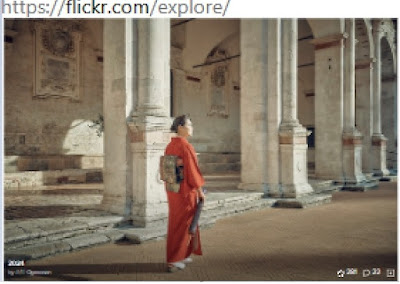 |
| credit: https://flickr.com/ogawasan/53436611120 on Jan. 2, 2024 |
This study in contrasts appears in the daily "explore" selection by photo editors at the FLICKR photo-sharing online service. Stone (cold) vs. flesh (warm), orange vs. white, light vs. shadow, and the cultural contrast of Japanese traditional clothing vs the architectural proportions and materials and details of ancient Greece and Rome. This collage of contrasts adds tension and attention in viewers' minds so that each side of the opposing pairs is amplified or intensified, much as sweet and sour recipes can make for intense flavor experiences. Were the figure an imagined, ideally shaped person dressed in period costume fitting the architecture's ancient root (say, in Roman toga), then the person and the building would be of the same style and period. Little tension or interest would come from that dimension of the picture.
In 2024 the volume of intercultural mingling and the degree of differences do not create the same shock or startling feeling of being out of place compared to 100 or 500 years ago when such intersections were less common or normalized. Many viewers today would be able to identify the cultural origins of figure and of ground. But a few generations ago far fewer would accurately recognize the source cultures. Another change from then to now comes from the presence of (bright) colors present in daily life of the average person. Today there is a riot of color-fast dyes in fabrics, of neon and LED and high-visibility materials including myriad plastics and paints. But 150 or more years ago, most people were rural and saw vivid colors only in the spring flowers and maybe (stained) glass or art on display. These relatively rare expressions of color paled in comparison to the overwhelming majority of muted, natural colors of the lived-in landscape: mud, fields, forests, and fabrics spun in a few natural dye colors.
Today the sensory environment of the average person is predominantly urban or suburban, surrounded by cascades of color-filled images in still and moving (digital) form, and comprising cultural features and language elements from multiple sources, not confined to geographically local or adjacent origins. In such an ocean of cultural citations across eras and cultures, modern viewers may well take for granted juxtapositions like the one photographed above. Instead of sensing artistic tension and attention, perhaps people looking at the picture today will perceive little more than the abstract expression of geometry, light, and accent color. The scenes is no more than "a graceful lady in some famous building; beauty on beauty to represent a synergy of more beauty than the sum of each of the parts" instead of "East meets West due to global flows of ideas and travel and leisure pursuits." Both interpretations are true: this is an intersection of so many contrasts, but if those things seem unremarkable to modern eyes, then also this can be seen as the additive effect of putting one cultural tradition of beauty together with another one.
No comments:
Post a Comment